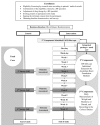Self-Monitoring by Traffic Light Color Coding Versus Usual Care on Outcomes of Patients With Heart Failure Reduced Ejection Fraction: Protocol for a Randomized Controlled Trial
- PMID: 30429118
- PMCID: PMC6262204
- DOI: 10.2196/resprot.9209
Self-Monitoring by Traffic Light Color Coding Versus Usual Care on Outcomes of Patients With Heart Failure Reduced Ejection Fraction: Protocol for a Randomized Controlled Trial
Abstract
Background: Patients with heart failure (HF) reduced ejection fraction (HFrEF) have symptoms that are more severe and experience a higher rate of hospitalization compared with HF preserved ejection fraction (HFpEF) patients. However, symptom recognition cannot be made by patients based on current approaches. This problem is a barrier to effective self-care that needs to be improved by new self-monitoring instruments and strategies.
Objective: This study describes a protocol for the self-monitoring daily diaries of weight and shortness of breath (SOB) based on the traffic light system (TLS). The primary objective is to compare the self-care between the intervention and control group. Comparison of HF knowledge, HF quality of life (HFQOL), and all-cause hospitalization between the 2 groups are the secondary objectives.
Methods: A single-blind randomized controlled trial is being conducted at the HF clinic at Tehran Heart Center (Tehran, Iran). Sixty-eight adult patients of both genders will be enrolled during admission to HF clinic. Eligible subjects will be assigned to either the intervention or control group by a block balanced randomization method. Baseline surveys will be conducted before random allocation. Participants in the intervention group will receive an integrated package consisting of (1) HF self-care education by an Australian Heart Foundation booklet on HF, (2) regular home self-monitoring of weight and SOB, and (3) scheduled call follow-ups for 3 months. Patients in the control group will receive no intervention and they only complete monthly surveys.
Results: This study is ongoing and is expected to be completed by the end of 2018.
Conclusions: This is the first trial with new self-monitoring instruments in Iran as a low and middle-income country. If the findings show a positive effect, the package will be applied in different regions with the same health care status.
Trial registration: Iranian Registry of Clinical Trials IRCT2017021032476N1; https://en.irct.ir/trial/25296?revision=25296 (Archived by WebCite at http://www.webcitation.org/73DLICQL8).
International registered report identifier (irrid): PRR1-10.2196/9209.
Keywords: clinical trial; heart failure; outcome; self-monitoring.
©Mahin Nomali, Ramin Mohammadrezaei, Abbas Ali Keshtkar, Gholamreza Roshandel, Shahrzad Ghiyasvandian, Kian Alipasandi, Masoumeh Zakerimoghadam. Originally published in JMIR Research Protocols (http://www.researchprotocols.org), 14.11.2018.
Conflict of interest statement
Conflicts of Interest: None declared.
Figures





Similar articles
-
Efficacy of a self-monitoring traffic light diary on outcomes of patients with heart failure: A randomized controlled trial.Int J Nurs Stud. 2024 Apr;152:104704. doi: 10.1016/j.ijnurstu.2024.104704. Epub 2024 Jan 28. Int J Nurs Stud. 2024. PMID: 38368847 Clinical Trial.
-
A Remote Medication Monitoring System for Chronic Heart Failure Patients to Reduce Readmissions: A Two-Arm Randomized Pilot Study.J Med Internet Res. 2016 Apr 17;18(5):e91. doi: 10.2196/jmir.5256. J Med Internet Res. 2016. PMID: 27154462 Free PMC article. Clinical Trial.
-
Use of home telemonitoring to support multidisciplinary care of heart failure patients in Finland: randomized controlled trial.J Med Internet Res. 2014 Dec 11;16(12):e282. doi: 10.2196/jmir.3651. J Med Internet Res. 2014. PMID: 25498992 Free PMC article. Clinical Trial.
-
Comparison of a one-time educational intervention to a teach-to-goal educational intervention for self-management of heart failure: design of a randomized controlled trial.BMC Health Serv Res. 2009 Jun 11;9:99. doi: 10.1186/1472-6963-9-99. BMC Health Serv Res. 2009. PMID: 19519904 Free PMC article. Clinical Trial.
-
Comparing the Effectiveness of Clinicians and Paraprofessionals to Reduce Disparities in Perinatal Depression via the Mothers and Babies Course: Protocol for a Cluster-Randomized Controlled Trial.JMIR Res Protoc. 2018 Nov 20;7(11):e11624. doi: 10.2196/11624. JMIR Res Protoc. 2018. PMID: 30459138 Free PMC article.
Cited by
-
Application of self-care based on full-course individualized health education in patients with chronic heart failure and its influencing factors.World J Clin Cases. 2019 Aug 26;7(16):2165-2175. doi: 10.12998/wjcc.v7.i16.2165. World J Clin Cases. 2019. PMID: 31531312 Free PMC article.
-
A qualitative study of nurses' experiences of self-care counseling in migrant patients with heart failure.Int J Nurs Sci. 2021 Jun 1;8(3):279-288. doi: 10.1016/j.ijnss.2021.05.004. eCollection 2021 Jul 10. Int J Nurs Sci. 2021. PMID: 34307776 Free PMC article.
-
PATROL: Participatory Activity Tracking and Risk Assessment for Anonymous Elderly Monitoring.Sensors (Basel). 2022 Sep 14;22(18):6965. doi: 10.3390/s22186965. Sensors (Basel). 2022. PMID: 36146314 Free PMC article.
References
-
- Yancy C, Jessup M, Bozkurt B, Butler J, Casey DJ, Drazner M, Fonarow G, Geraci S, Horwich T, Januzzi James L, Johnson Maryl R, Kasper Edward K, Levy Wayne C, Masoudi Frederick A, McBride Patrick E, McMurray John J V, Mitchell Judith E, Peterson Pamela N, Riegel Barbara, Sam Flora, Stevenson Lynne W, Tang W H Wilson, Tsai Emily J, Wilkoff Bruce L. 2013 ACCF/AHA guideline for the management of heart failure: executive summary: a report of the American College of Cardiology Foundation/American Heart Association Task Force on practice guidelines. Circulation. 2013 Oct 15;128(16):1810–52. doi: 10.1161/CIR.0b013e31829e8807.CIR.0b013e31829e8807 - DOI - PubMed
-
- Ziaeian B, Fonarow Gregg C. Epidemiology and aetiology of heart failure. Nat Rev Cardiol. 2016 Dec;13(6):368–78. doi: 10.1038/nrcardio.2016.25. http://europepmc.org/abstract/MED/26935038 nrcardio.2016.25 - DOI - PMC - PubMed
-
- Callender T, Woodward M, Roth G, Farzadfar F, Lemarie J, Gicquel S, Atherton J, Rahimzadeh S, Ghaziani M, Shaikh Maaz, Bennett Derrick, Patel Anushka, Lam Carolyn S P, Sliwa Karen, Barretto Antonio, Siswanto Bambang Budi, Diaz Alejandro, Herpin Daniel, Krum Henry, Eliasz Thomas, Forbes Anna, Kiszely Alastair, Khosla Rajit, Petrinic Tatjana, Praveen Devarsetty, Shrivastava Roohi, Xin Du, MacMahon Stephen, McMurray John, Rahimi Kazem. Heart failure care in low- and middle-income countries: a systematic review and meta-analysis. PLoS Med. 2014 Aug;11(8):e1001699. doi: 10.1371/journal.pmed.1001699. http://dx.plos.org/10.1371/journal.pmed.1001699 PMEDICINE-D-13-04109 - DOI - DOI - PMC - PubMed
-
- Ahmadi Ali, Etemad Koorosh, Khaledifar Arsalan. Risk factors for heart failure in a cohort of patients with newly diagnosed myocardial infarction: a matched, case-control study in Iran. Epidemiol Health. 2016;38:e2016019. doi: 10.4178/epih.e2016019. doi: 10.4178/epih.e2016019.epih.e2016019/ - DOI - DOI - PMC - PubMed
LinkOut - more resources
Full Text Sources
Research Materials
Miscellaneous

